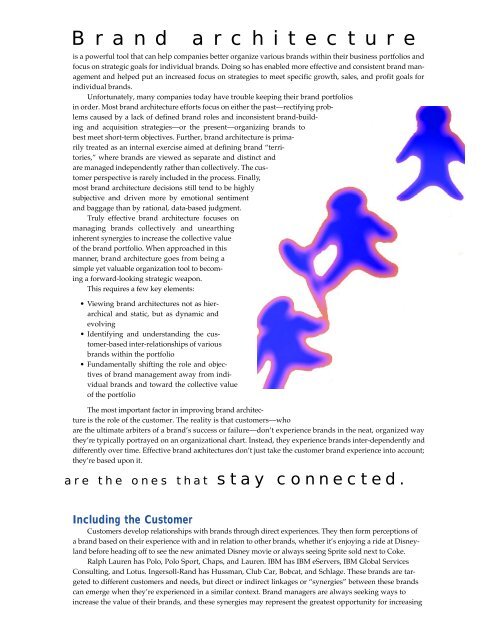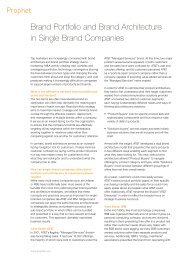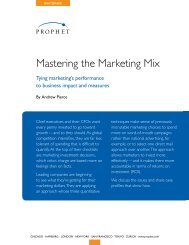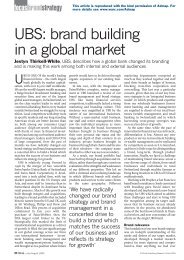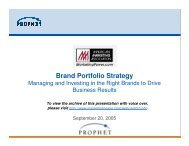Download - Prophet
Download - Prophet
Download - Prophet
You also want an ePaper? Increase the reach of your titles
YUMPU automatically turns print PDFs into web optimized ePapers that Google loves.
B r a n d a r c h i t e c t u r e<br />
is a powerful tool that can help companies better organize various brands within their business portfolios and<br />
focus on strategic goals for individual brands. Doing so has enabled more effective and consistent brand management<br />
and helped put an increased focus on strategies to meet specific growth, sales, and profit goals for<br />
individual brands.<br />
Unfortunately, many companies today have trouble keeping their brand portfolios<br />
in order. Most brand architecture efforts focus on either the past––rectifying problems<br />
caused by a lack of defined brand roles and inconsistent brand-building<br />
and acquisition strategies—or the present––organizing brands to<br />
best meet short-term objectives. Further, brand architecture is primarily<br />
treated as an internal exercise aimed at defining brand “territories,”<br />
where brands are viewed as separate and distinct and<br />
are managed independently rather than collectively. The customer<br />
perspective is rarely included in the process. Finally,<br />
most brand architecture decisions still tend to be highly<br />
subjective and driven more by emotional sentiment<br />
and baggage than by rational, data-based judgment.<br />
Truly effective brand arc h i t e c t u re focuses on<br />
managing brands collectively and unearthing<br />
i n h e rent synergies to increase the collective value<br />
of the brand portfolio. When approached in this<br />
m a n n e r, brand arc h i t e c t u re goes from being a<br />
simple yet valuable organization tool to becoming<br />
a forward-looking strategic weapon.<br />
This requires a few key elements:<br />
• Viewing brand architectures not as hierarchical<br />
and static, but as dynamic and<br />
evolving<br />
• Identifying and understanding the customer-based<br />
inter-relationships of various<br />
brands within the portfolio<br />
• Fundamentally shifting the role and objectives<br />
of brand management away from individual<br />
brands and toward the collective value<br />
of the portfolio<br />
The most important factor in improving brand arc h i t e c-<br />
t u re is the role of the customer. The reality is that customers––who<br />
a re the ultimate arbiters of a brand’s success or failure––don’t experience brands in the neat, organized way<br />
t h e y ’ re typically portrayed on an organizational chart. Instead, they experience brands inter-dependently and<br />
d i ff e rently over time. Effective brand arc h i t e c t u res don’t just take the customer brand experience into account;<br />
t h e y ’ re based upon it.<br />
a r e t h e o n e s t h a t s t a y c o n n e c t e d .<br />
Including the Customer<br />
Customers develop relationships with brands through direct experiences. They then form perceptions of<br />
a brand based on their experience with and in relation to other brands, whether it’s enjoying a ride at Disneyland<br />
before heading off to see the new animated Disney movie or always seeing Sprite sold next to Coke.<br />
Ralph Lauren has Polo, Polo Sport, Chaps, and Lauren. IBM has IBM eServers, IBM Global Services<br />
Consulting, and Lotus. Ingersoll-Rand has Hussman, Club Car, Bobcat, and Schlage. These brands are targeted<br />
to different customers and needs, but direct or indirect linkages or “synergies” between these brands<br />
can emerge when they’re experienced in a similar context. Brand managers are always seeking ways to<br />
increase the value of their brands, and these synergies may represent the greatest opportunity for increasing


